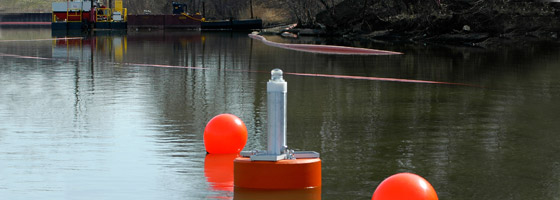Monitoring Turbidity at Dredging Sites

The current number of restoration initiatives is extremely high due to recognition and stressed importance of keeping our waterways healthy. The Great Lakes Restoration Initiative, for instance, “is the largest investment in the Great Lakes in two decades*,” created to bring numerous ‘Areas of Concern’ back to life. Ample federal funding has provided the opportunity for many restoration and clean-up projects to take place; of those, dredging, or the removal of contaminated sediment from an unhealthy waterway, has been a priority.
Strict guidelines have been cooperatively set by the U S Environmental Protection Agency and U S Army Corps of Engineers for contaminated sediment remediation projects with the ultimate goal of ensuring that water remains sufficiently healthy for both wildlife and humans during a given project. In order to prove this, effectively monitoring turbidity, or suspended sediments, is crucial to meet technical guidelines.
 These guidelines stress the importance of implementing a monitoring strategy that provides rapid feedback so dredge operators can respond to high re-suspension levels before they become problematic. Real-time monitoring is advised so that rapid responses are achievable.
These guidelines stress the importance of implementing a monitoring strategy that provides rapid feedback so dredge operators can respond to high re-suspension levels before they become problematic. Real-time monitoring is advised so that rapid responses are achievable.
NexSens Technology buoy-based platforms and data loggers offer a high-performance solution for monitoring turbidity in real time, designed to accommodate the specific needs of portable dredge monitoring systems. The platform consists of a NexSens MB-300 data buoy fully equipped with an SDL500 submersible data logger, turbidity sensor, three solar power packs and a mooring assembly to ensure the systems will remain in location.
The MB-300 data buoy offers a stable platform with on-board data logging and telemetry, a center well for sensor deployment and capacity for three solar power packs. The SDL500 submersible data logger includes five sensor ports to accommodate multiple turbidity probes in the water column; turbidity data is sampled and logged with a time and date stamp. This data logger also offers a plug-and-play interface for most third-party turbidity probes, including YSI, Hydrolab, In-Situ, Campbell Scientific and WET Labs. NexSens iChart 6 Software and optional WQData Web Datacenter allow dredge operators to access real-time turbidity data, and generate reports to show that the project is meeting technical guidelines.
With this system in place, field staff are able to monitor water conditions during a project, ensuring that dredging operations do not cause particle re-suspension issues. If unacceptable turbidity levels are observed, the staff would be able to immediately notify the dredge operators to shut down or alter operations.
For additional information on turbidity dredge monitoring, please email customercare@fondriest.com or call 888.426.2151.
*Credit: http://greatlakesrestoration.us/





0 comments